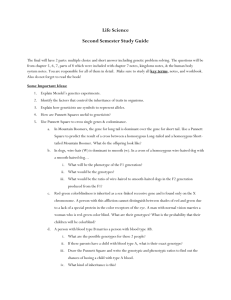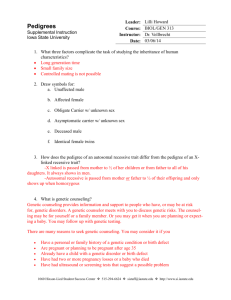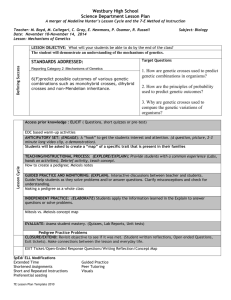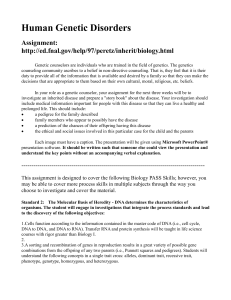Pedigree Project Instructions
advertisement
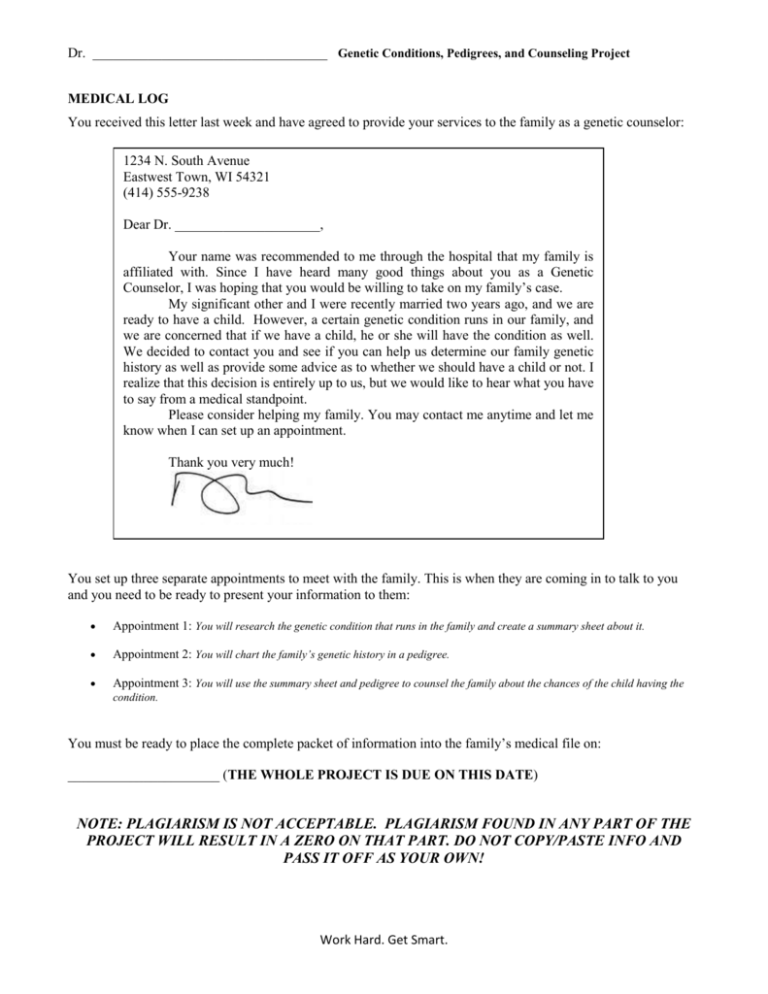
Dr. __________________________________ Genetic Conditions, Pedigrees, and Counseling Project MEDICAL LOG You received this letter last week and have agreed to provide your services to the family as a genetic counselor: 1234 N. South Avenue Eastwest Town, WI 54321 (414) 555-9238 Dear Dr. _____________________, Your name was recommended to me through the hospital that my family is affiliated with. Since I have heard many good things about you as a Genetic Counselor, I was hoping that you would be willing to take on my family’s case. My significant other and I were recently married two years ago, and we are ready to have a child. However, a certain genetic condition runs in our family, and we are concerned that if we have a child, he or she will have the condition as well. We decided to contact you and see if you can help us determine our family genetic history as well as provide some advice as to whether we should have a child or not. I realize that this decision is entirely up to us, but we would like to hear what you have to say from a medical standpoint. Please consider helping my family. You may contact me anytime and let me know when I can set up an appointment. Thank you very much! You set up three separate appointments to meet with the family. This is when they are coming in to talk to you and you need to be ready to present your information to them: Appointment 1: You will research the genetic condition that runs in the family and create a summary sheet about it. Appointment 2: You will chart the family’s genetic history in a pedigree. Appointment 3: You will use the summary sheet and pedigree to counsel the family about the chances of the child having the condition. You must be ready to place the complete packet of information into the family’s medical file on: ______________________ (THE WHOLE PROJECT IS DUE ON THIS DATE) NOTE: PLAGIARISM IS NOT ACCEPTABLE. PLAGIARISM FOUND IN ANY PART OF THE PROJECT WILL RESULT IN A ZERO ON THAT PART. DO NOT COPY/PASTE INFO AND PASS IT OFF AS YOUR OWN! Work Hard. Get Smart. Circle which genetic condition you are researching (one person per condition): * = No outward physical defects related to the condition. If you choose one of these genetic conditions, you will need to find a picture of something related to the condition rather than a picture of someone who has it. Waardenburg Syndrome Sickle Cell Anemia* Marfan Syndrome Color Blindness: Red-Green* Color Blindness: Blue-Yellow* Werner Syndrome Huntington Disease Lenz Microphthalmia Syndrome Noonan Syndrome Muscular Dystrophy: Duchenne Neurofibromatosis: Type I Tay-Sachs Disease Achondroplasia Nail-patella Syndrome Maple Syrup Urine Disease* Cystic Fibrosis* Cherubism Achromatopsia Cornelia de Lange Syndrome Bloom Syndrome Pachyonychia Congenita Phenylketonuria (PKU)* Tuberous Sclerosis Pallister-Hall Syndrome Treacher Collins Syndrome Fragile X Syndrome Feingold Syndrome Go to this website to gather the majority of your information: http://ghr.nlm.nih.gov/BrowseConditions. Appointment 1: Summary Sheet Create a summary sheet to briefly explain the genetic condition to the family. This summary sheet must be typed, in bullet (not paragraph) format, and contain all of the information listed below. DO NOT copy/paste right off of the website. Titles o Somewhere at the top of the page, include your name as “Dr. _______” o Title the page with the name of the genetic condition that you are researching Questions: Use the following headings. Using bullets, place the answers under the headings. o SIGNS AND SYMPTOMS What are the signs and symptoms of the genetic condition? o HOW COMMON IS IT? Statistically, how common is the genetic condition? This means you should have #s in your answer! If applicable, is it more common in men, women, or a certain ethnic group? o GENE(S) OF RELEVANCE What gene(s) is/are of relevance? o HOW IT IS INHERITED Is it autosomal dominant, autosomal recessive,sex-linked dominant, or sex-linked recessive? You shouldn’t have anything else other than one of those four options! o DIAGNOSIS What are some tests/ways to diagnose the condition? (You may have to look at other sites) o TREATMENT Is the condition curable? Is the condition treatable? (You may have to look at other websites) o OTHER Give me 3 other interesting facts about the condition (You may have to look at other websites) Picture: go to Google or another search engine and find a picture of someone who has the genetic condition. If you chose a condition with a *, remember, you won’t be able to find a picture of someone who has it. Instead, find a picture of something RELEVANT to the condition. YOU MAY USE THIS CHECKLIST TO MAKE SURE YOU HAVE EVERYTHING YOU NEED: Summary Sheet (extra points available for making the summary sheet look fancy) __ It’s typed __ How common it is __ Fact 1 __ Proper format (headings + bullets) __ Genes of relevance __ Fact 2 __ Your name (Dr. __) __ Pattern of inheritance __ Fact 3 __ Condition name in title __ Tests/ways to diagnose __ Relevant picture __ Signs/symptoms __ Treatable? __ No plagiarism! Work Hard. Get Smart. Appointment 2: Construct a Pedigree You are now going to use information you gathered about the genetic condition to construct a pedigree for the family you are counseling. Follow these steps to correctly construct your pedigree—you may want to do it in pencil first. If you need help, make sure you ask! 1. FORMAT: Grab a blank piece of paper—NO LINES—and turn it in the landscape (the long way/sideways) direction. 2. TITLES: At the top, write: a. The name of the genetic condition b. The last name of the family you are counseling (make a last name up!) c. How the condition is inherited (autosomal dominant, autosomal recessive, sex-linked dominant, or sex-linked recessive) 3. KEY: On the side of the paper, make a key. Include how you represent: a. The meaning of the symbols you are going to use (and ONLY the ones you use) b. What the different shadings mean 4. GENERATION 1: Begin to make your pedigree. Somewhere near the top/middle of the page, make a circle (female) and a square (male) joined by a horizontal marriage line. These are the grandparents of your family. a. Provide a name for each person under their circle/square. b. Either on the marriage line or off to the side (at the same level as the grandparents), write “Generation 1.” c. Choose a letter to represent the alleles for the condition. For example, if you choose Tay Sachs, you might choose the letter T/t. Under each person’s name, write their genotype (make this up for each person!). d. Based on the genotypes you give each person, shade them in accordingly. e. Create a Punnett Square using the alleles of the couple you just made to determine the probability of their children having the condition. Write out the probabilities of every possible genotype of their children. f. ATTACH YOUR PUNNETT SQUARES AS A SEPARATE SHEET OF PAPER. Label them as 4e, 5e, and 6e. 5. GENERATION 2: Use a vertical line between your grandma/grandpa to drop down to the next generation. Make branches for their children. a. Provide a name for each person under their circle/square. b. Either on the sibling line or off to the side (at the same level as all the siblings), write “Generation 2.” c. Using the genetic probabilities you calculated in part 4e, write the genotypes of each person under their name and shade each person appropriately. Example: if your Punnett Square from step 4e gives you genotypes Tt (50%) and TT (50%), no one in Generation 2 should have the genotype tt. d. At minimum one person from Generation 2 needs to get married. Connect the person and their spouse by a solid horizontal line. Remember to name the spouse, provide their genotype (they married in, so their genotype can be whatever you want), and shade them accordingly. e. For every married couple (with children) in the 2nd generation, create a Punnett Square with their alleles to determine the probability of their children having the condition. Like before, write out the possible probabilities of each genotype. Work Hard. Get Smart. 6. GENERATION 3: Use a vertical line between the married couples from Generation 2 to drop down to the next generation. Make branches for their children. a. Provide a name for each person under their circle/square. b. Either on the sibling line or off to the side (at the same level as all the siblings), write “Generation 3.” c. Using the genetic probabilities you calculated in part 5e, write the genotypes of each person under their name and shade each person appropriately. d. At minimum one person from Generation 3 needs to get married. Connect the person and their spouse by a solid horizontal line. Remember to name the spouse. ANYONE WHO MARRIES IN AT THIS LEVEL MUST BE HETEROZYGOUS. Write each person’s genotype and shade them in as appropriate. (exception: if you have a sex-linked disorder and the person marrying in is a male, he should HAVE the disorder.) e. Choose the married couple (someone from the family + the heterozygote) and create a Punnett Square with their alleles to determine the probability of their children (the fourth generation) having the condition. THIS IS THE COUPLE YOU ARE GOING TO GENETICALLY COUNSEL AS TO HOW LIKELY THEIR CHILD IS TO HAVE THE CONDITION! 7. EXTRA CREDIT OPTIONS: a. You can earn extra credit points for making your pedigree on a computer. Good programs to do this in include Paint and PowerPoint. b. You can earn extra credit points for making more than 3 generations, but the maximum is 5. If you do 4 or 5 generations, make sure you provide a Punnett Square for every couple that has children. Also, instead of genetically counseling someone from your 3rd generation, you’ll just choose a married couple from your final generation. Make sure that whoever marries in at this level is a heterozygote of the condition! Use this checklist to make sure you have everything! Pedigree (extra points available for neatness if hand-drawn or for typing this part- try Paint or PowerPoint) __ It’s neat __ It’s on 8 ½ x 11 paper (or larger) __ The paper has no lines __ In title: condition name __ In title: pattern of inheritance __ In title: last name of family __ Key: male vs female __ Key: shading __ Key: other symbols used __ 3 minimum generations __ 5 maximum generations __ marriage at each level __ family to counsel- one is carrier __ Label: Generation # __ Label: People’s names __ Label: People’s genotypes __ Proper shading, symbols, lines __ Punnett Squares __ Percents of genotypes Work Hard. Get Smart. Appointment 3: Genetic Counseling Now it is time to use the information you gathered about the genetic condition and the family’s genetic history to counsel the family about having a child. Type up this Genetic Counseling Form with the same headings and information listed below. Points will be lost for not following this format. GENETIC CONDITION HOW IT IS INHERITED (Autosomal Dominant, etc) THE LAST NAME OF THE FAMILY ON THE PEDIGREE Mother: _____(her name)_______ use the 3rd generation mother you are genetically counseling Her genotype Her phenotype Father: ______(his name)_________ use the 3rd generation father you are genetically counseling His genotype His phenotype Probability of passing the condition on: Here, draw the Punnett Square for the mother and father you are genetically counseling. You drew this on your Pedigree already, so you can re-copy it here. Also, write the percentages of each possible genotype and phenotype. Counseling: minimum of 200 words! Here, think about the symptoms and the fatality of the genetic condition. Take a look at how high the chances are of the potential child having the condition. Make a decision using these factors and anything else you think is relevant: would you suggest that the couple should or should not have a child? Explain why or why not. Write this like you are writing it to the family—that means it’s ok to say “I” and “you.” Use this checklist to make sure you have everything that you need! Genetic Counseling (extra points available for creativity) __ It’s typed __ Uses specific format __ In title: family name __ In title: genetic condition __ In title: pattern of inheritance __ Counseling – 200 words __ Mother’s name, phenotype, genotype __ Father’s name, phenotype, genotype __ Punnett Square __ %s for possible genotypes/phenotypes __ Counseling—explained well When you turn in the project (the whole medical record), staple Appointments 1, 2, 3, and Punnett Squares from your Pedigree together (the summary sheet, pedigree, and genetic counseling sheet, Punnett Squares). Work Hard. Get Smart. Work Hard. Get Smart.
